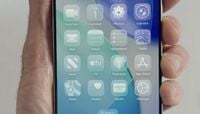Apple is steadily rolling out updates across its ecosystem with the release of iPadOS 26 Beta 3 and ongoing developments in iOS 26, signaling a significant evolution in user experience, design, and messaging capabilities. As Apple prepares for the public beta phase and eventual full release, these updates showcase the company's commitment to blending innovative features with practical usability enhancements.
Released around July 9, 2025, iPadOS 26 Beta 3 introduces a series of refinements that aim to enhance both functionality and aesthetics. One of the standout features is the expanded wallpaper options, which now include additional color variations that allow users to personalize their iPads more extensively. This update reflects Apple's understanding of the importance of device customization, making the iPad feel more tailored to individual tastes.
Alongside aesthetic improvements, Apple has introduced a new "Shake to Enlarge" gesture for the cursor, a feature borrowed from macOS. This functionality significantly boosts cursor visibility by temporarily enlarging it when users shake their finger or trackpad. Particularly useful for those multitasking or using external displays, this feature addresses a common usability challenge, facilitating precise navigation and editing tasks.
The visual design has also been a focus in this beta. Apple's innovative Liquid Glass design, first unveiled at WWDC 2025, has undergone subtle but meaningful adjustments. The ultra-transparent, see-through look has been dialed back to improve text readability and overall user experience. Specifically, translucency effects now have reduced opacity, with increased contrast applied across native apps such as Music, Files, and Safari. For example, the Apple Music navigation bar has shifted from semi-transparent to a solid white background, and notifications now feature darker backgrounds to enhance visibility.
These design tweaks have sparked mixed reactions. Some users and developers appreciate the improved accessibility and usability, noting that the original design was sometimes "too flashy" or difficult to read. Sam Kohl of AppleTrack remarked on social media that "iOS 26 beta 3 completely nerfs Liquid Glass," suggesting that the changes make the interface feel less premium. Meanwhile, design experts like Allan Yu, formerly of Shopify and Facebook, believe the recent beta might have gone too far in reversing earlier aesthetic advances. Calls for customizable transparency settings are growing, with users hoping Apple will allow them to choose their preferred balance of style and function.
System stability also remains a priority in iPadOS 26 Beta 3. Apple has addressed several performance issues flagged in earlier betas, resulting in a smoother, more reliable experience. This focus on polishing the software signals Apple's intent to deliver a dependable operating system ahead of the public beta and final releases.
Meanwhile, iOS 26, which was also previewed at WWDC 2025, promises to be the most significant update to iPhone usage since iOS 7 in 2013. Among its many new features are a redesigned Phone app that includes call screening for unknown numbers—where callers must state their name and reason, and users receive a transcript before deciding to answer—and a hold assist feature that alerts users when it's their turn in a queue, freeing them from waiting on hold.
Battery management sees improvements too, with iPhones now displaying time estimates for reaching 80% and full charge, a feature long available on Android devices like the Pixel 9 and Samsung Galaxy S25 Ultra. The Messages app is receiving several user-friendly updates, including customized chat backgrounds, filtering messages from unknown senders, and the ability to create polls within group chats. Apple Intelligence may even suggest poll creation based on conversation context, adding a smart touch to communication.
Additional enhancements include the ability to adjust alarm snooze durations anywhere from one to fifteen minutes, a welcome change from the fixed nine-minute snooze in previous iOS versions. AirPods Pro 2 and AirPods 4 users gain remote camera controls, enabling them to start or stop video recording and take photos via new settings in the AirPods app.
iOS 26 also brings PDF editing capabilities to the iPhone, akin to the Mac's Preview app, allowing users to highlight text, add notes, search documents, and insert signatures without third-party apps. Visual intelligence expands to enable searching anything on the iPhone screen by taking a screenshot and highlighting elements, with prompts to add recognized dates and times to calendars.
Language barriers are further bridged with live translation features in calls and messages, supporting multiple languages including English, German, Spanish, French, Italian, Japanese, Korean, Portuguese, and Chinese. The lock screen becomes more dynamic, with a clock that moves along with photo shuffle wallpapers, customizable fonts and colors, and a spatial scene option that adds depth to 2D photos, giving them a 3D effect.
The Reminders app benefits from an "auto categorise" feature powered by Apple Intelligence, which organizes lists into action groups, though this requires newer iPhone models. All these new features are wrapped in the Liquid Glass user interface, which gives app icons a translucent, semi-reflective look, with menus and navigation bars floating above content to reduce clutter.
Despite the excitement, some features remain works in progress. For instance, support for end-to-end encrypted Rich Communication Services (RCS) messages, announced by Apple in March 2025, has yet to be implemented in the Messages app as of the third developer beta of iOS 26. Apple has confirmed it will support RCS Universal Profile 3.0, which includes encryption and other iMessage-like enhancements such as in-line replies, message editing, unsending, and full Tapback support. However, this rollout depends on carrier adoption of the new RCS standard, explaining the delay.
RCS itself was introduced to the iPhone with iOS 18, supporting Universal Profile 2.4, but Apple’s iMessage has long had features like end-to-end encryption (since iOS 5), in-line replies (since iOS 14), and edit/unsend options (since iOS 16). The upcoming RCS upgrades are expected to arrive during the iOS 26 software cycle, bringing parity with iMessage’s capabilities.
Apple’s Worldwide Developer Conference in June 2025 set the stage for these sweeping updates, which are now being refined through developer betas ahead of a public beta release starting in July and a final public release anticipated in mid-September 2025, coinciding with the launch of new iPhone models. The updates support a wide range of devices, from the latest iPhone 16 series down to the iPhone 11 and iPhone SE (2nd generation or later), though some of the AI-powered features require newer hardware like the iPhone 16 or iPhone 15 Pro models.
As Apple continues to balance bold design ambitions with user feedback, the evolution of iOS and iPadOS in 2025 highlights the company's dedication to innovation without sacrificing practicality. Users can look forward to a more personalized, accessible, and intelligent experience across their Apple devices in the months ahead.




